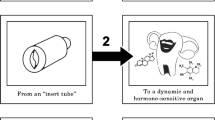Abstract
UP to the present, the physiological classification and terminology of steroid hormones was based either on one of their outstanding actions (‘œstrogens’, ‘progestins’) or on their source of origin (‘corpus luteum hormone’, ‘adrenal cortical hormone’, ‘testis hormone’). Such a classification is no longer possible, since we know, for example, that ‘testis hormones’ may originate in the adrenal cortex and may exert ‘œstrogenic’ actions. In spite of the considerable overlapping between the physiological actions of the steroid hormones, they can and must be classified into certain groups. It is felt that the best solution of the problem is to classify the steroid hormone actions according to the degree to which they are able to imitate or substitute for the function of a certain endocrine gland. Accordingly these groups might be given names reminiscent of the glands and yet indicating that this does not imply that such glands are the only source of the hormone.
Similar content being viewed by others
References
Callow, R. K., and Young, F. G., Proc. Roy. Soc., A, 157, 194 (1936).
Hartman, Frank A., Spoor, H. J., and Lewis, L. A., Science, 89, 204 (1939).
Author information
Authors and Affiliations
Rights and permissions
About this article
Cite this article
SELYE, H. Pharmacological Classification of Steroid Hormones. Nature 148, 84–85 (1941). https://doi.org/10.1038/148084c0
Issue Date:
DOI: https://doi.org/10.1038/148084c0
- Springer Nature Limited
This article is cited by
-
Origins and impact of the term ‘NSAID’
Inflammopharmacology (2014)





